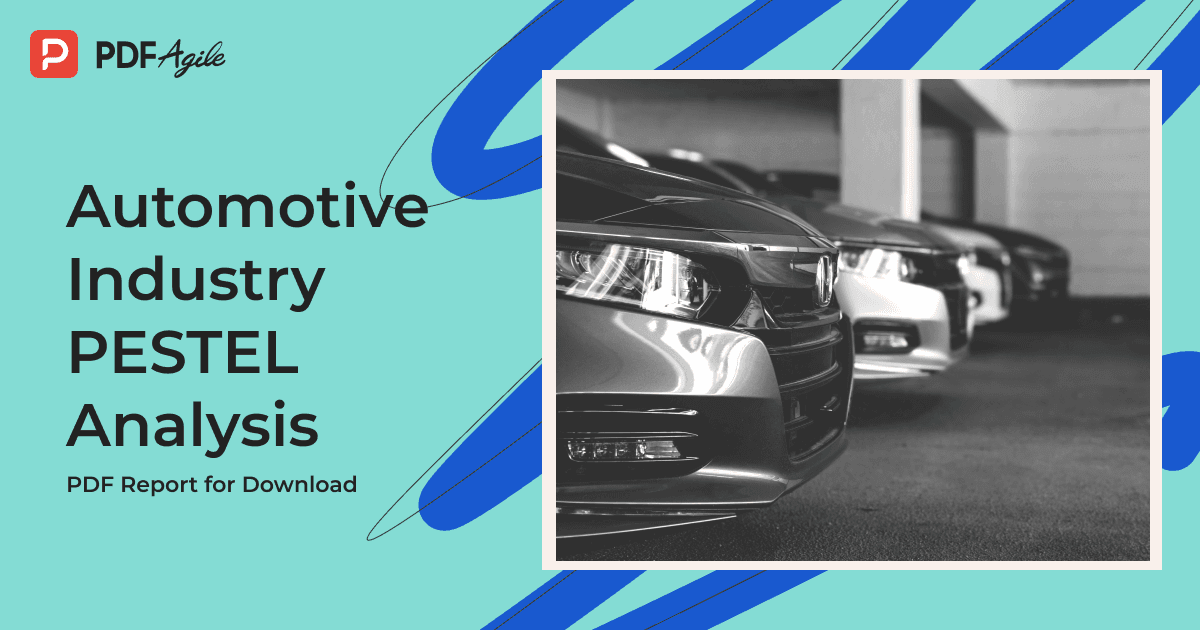An industry's macroenvironment can be analysed using a PESTLE analysis. Factors in the realms of politics, business and technology are collectively referred to as PESTLE. In this way, a business might get a sense of what might affect a new venture or industry and can identify the most important external factors that affect its operations in order to become more competitive.
All companies and activities engaged in the construction of motor cars, including most components such as engines and bodywork, but excluding tires, batteries, and gasoline, are referred to as the automotive industry. Passenger cars and light trucks, such as pickups, vans, and sport utility vehicles, are the mainstays of the sector.
The PESTEL analysis is an important part of management research. External factors such as politics, economy, society, technology, ecology, and legislation can all have an impact on the automotive industry's sales. The PESTEL analysis of the automotive industry demonstrates how various elements can influence the industry's growth. It aids businesses in developing ways to mitigate potential risks.
Background of the Automotive Industry
The invention of the gasoline engine between the 1860s and 1970s, primarily in Germany and France, is considered to be the starting point of the automotive industry. This is despite the fact that steam-powered road vehicles were manufactured earlier. At the turn of the 20th century, manufacturers from the United Kingdom, Italy, and the United States joined their counterparts from Germany and France.
In today's globe, the vehicle business is thriving. In many developed countries, cars are not only a source of transportation, but they are also an integral part of the culture. Since environmental restrictions and taxes have slowed the industry's expansion due to rising gas prices, new technology has offered a new market. In 2016, the automotive industry had an EBIT margin of 6%, making it extremely profitable.

PESTEL analysis of the Automotive Industry
The PESTEL analysis of the automobile industry reveals how several external factors can have an impact on the company's operations. The car business is expanding in tandem. As a result, businesses will be able to figure out how to fix problems with the shift in people's way of life. Automotive PESTEL analysis illustrates the challenges
Political factors
In a country's periphery, business is directly impacted by politics. Analysis of automobile business PESTEL reveals how political problems might affect the automobile sector.
- To protect passengers, governments of most countries limit vehicle part production. If a corporation doesn't satisfy standards, its licence may be revoked and launch prep takes time and money.
- The administrations also want to limit the use of fossil fuels, which produce more pollutants, because of this. To stay in business, automotive manufacturers must keep their emissions within a certain limit.
Economical factors
The state of a nation's economy directly influences the way individuals live their lives. Consequently, it may potentially have an effect on the automotive sector.
- People living in stable and developing economies are seeing their incomes rise on a daily basis. As a result, their ability to spend is increasing. Because of this, the demand for automobiles is on the rise.
- If the price of automobile parts goes up, the overall cost of the vehicles will likewise go up to reflect this. It's possible that this is why there has been a drop in demand for autos.
Social factors
Sociocultural variables affect local businesses. Social trends affect car manufacture. PESTEL analysis reveals social conditions that can impair the car sector.
- Aside from their use, automobiles are also fashion statements. As a result, automakers must take the preferences of consumers into account while designing new models. If it doesn't sell well, it could go out of style.
- A country's population distribution has an effect on the sales of automobiles. It's no surprise that states with a high density of people and families tend to sell more large cars.
Technological factors
Technology affects automaker sales. People are more likely to buy cutting-edge technology vehicles than those without it
- The vehicle business relies heavily on cutting-edge technology to keep people safe. To ensure that their vehicles are as safe as possible, car manufacturers must constantly improve their technology.
- Emissions reductions must be the primary focus of the businesses involved. They can reduce emissions with the use of current technology.
Environmental factors
Environmental issues affect the auto sector. Pollution concerns may affect their business as they grow. PESTEL study identifies environmental issues that potentially harm the automobile industry.
- Environmentalists and the government are concerned about automobile emissions. It is possible for corporations to use their most recent technology to produce battery- or electric-powered vehicles, which can help reduce pollution.
- Automobile research units must be quite thorough in their testing. If it can pass the stringent pollution tests, they should put it on the market.
Legal factors
The business of the vehicle industry is susceptible to being influenced by the laws and regulations of the countries. The majority of nations' legal systems have provisions for car manufacturers.
- In many nations, there are stringent regulations in place to reduce the number of vehicles on the road, which helps to bring down the overall amount of pollution in the air.
- In order to do business internationally, a vehicle manufacturer must comply with local tax and environmental regulations. The corporation could be barred from operating in the country if they don't comply.
Automobile Industry PESTEL analysis PDF
Political factors
| Economical factors
|
Social factors
| Technological factors
|
Environmental factors
| Legal factors
|
Changes to downloaded PDF reports are difficult because of the document's inability to change file type, extract text, or even edit the document itself. For students and professionals alike, PDF report format is a fantastic resource. You can now merge, compress, and alter PDF reports in only a few clicks thanks to PDF Agile's ground-breaking capabilities. Creating PDFs from Word, Excel, and PowerPoint documents is likewise a simple process. The PESTEL study of Automobile Industry PDF reports can be modified using PDF Agile.
Key Takeaways
As countries' lifestyles and economies change, the auto sector may grow rapidly. For stability, they must address safety and environmental issues. The Automotive industry's PESTEL research suggests it can withstand possible threats. Then they can expand in developed and developing countries.
References
- EdrawMax Online “Detailed PESTEL Analysis of Automobile Industry”: From https://www.edrawmax.com/article/automobile-industry-pestel-analysis.html
- Pestleanalysis.com “PESTLE Analysis of the Automotive Industry”: From https://pestleanalysis.com/pestle-analysis-of-the-automotive-industry/
- SWOT & PESTLE Analysis “PESTLE Analysis of Automobile Industry”: From https://swotandpestleanalysis.com/pestle-analysis-of-automobile-industry/





